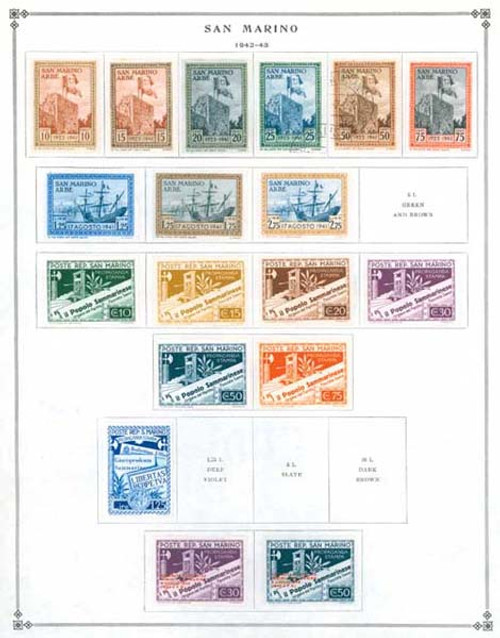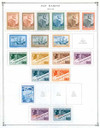
# MCC276 - 1877-1975 San Marino
Issue Dates: 1877-1975
Scott Catalogue Value: $1,711.45
Mystic Price: $940.00
You Save: $771.45
Interesting collection highlighted by sheet of six #304 stamps in mint condition (catalogue value $275). Also features high-value 1892 surcharged #28 in unused condition with small flaws. Back of the Book issues include Airmail, Parcel Post, Postage Due, Semi-postal and Special Delivery stamps. Includes a total of 574 stamps, most in mint condition, plus more than 50 album pages.
Located in the Apennine Mountains of northeastern Italy, San Marino is the world?s smallest republic. It covers an area of just 24 square miles and is inhabited by approximately 24,000 people. San Marino is built on three peaks of Mt. Titano, making the soil rocky. However, due to its warm summer climate and adequate rainfall, farmers are able to grow a number of crops. Farming and the production of postage stamps are important parts of the economy. The chief source of income, however, is the tourism industry. Two and a half million tourists visit San Marino each year.
Founded as a refuge for persecuted Christians in 300 A.D., San Marino is thought to be the oldest state in Europe. It became a republic in the 1300s and for the next 200 years defended itself against frequent attacks. The Pope formally recognized San Marino's independence in 1631, and in 1862 it signed a treaty of friendship with Italy.
San Marino's principal language is Italian, and its population is mostly Roman Catholic. Although they share many customs with Italy, they do take their independence very seriously. Most San Marinese can read and write; many have some form of higher education. The country also has a music school.
The government of San Marino has many different branches. First, the electoral body is known as the Arengo. The Arengo meets every six months to give citizens the opportunity to present requests and proposals to the Great and General Council. The Great and General Council is a board of sixty members who are elected every five years. They not only hear the proposals of the citizens, but also approve the budget and elect the Captains Regent. The latter is elected every six months and serves as the executive branch.
Although San Marino has a reputation for being fiercely independent, the citizens are proud of the fact that they have never refused asylum to those being persecuted. In 1849, Giuseppe Garibaldi found himself surrounded by three different enemy armies. Knowing he was in danger, he fled to the safety of San Marino. Then, after World War II, San Marino took in over 10,000 refugees. It is this pride and self-reliance that has made San Marino a successful republic for hundreds of years.
Issue Dates: 1877-1975
Scott Catalogue Value: $1,711.45
Mystic Price: $940.00
You Save: $771.45
Interesting collection highlighted by sheet of six #304 stamps in mint condition (catalogue value $275). Also features high-value 1892 surcharged #28 in unused condition with small flaws. Back of the Book issues include Airmail, Parcel Post, Postage Due, Semi-postal and Special Delivery stamps. Includes a total of 574 stamps, most in mint condition, plus more than 50 album pages.
Located in the Apennine Mountains of northeastern Italy, San Marino is the world?s smallest republic. It covers an area of just 24 square miles and is inhabited by approximately 24,000 people. San Marino is built on three peaks of Mt. Titano, making the soil rocky. However, due to its warm summer climate and adequate rainfall, farmers are able to grow a number of crops. Farming and the production of postage stamps are important parts of the economy. The chief source of income, however, is the tourism industry. Two and a half million tourists visit San Marino each year.
Founded as a refuge for persecuted Christians in 300 A.D., San Marino is thought to be the oldest state in Europe. It became a republic in the 1300s and for the next 200 years defended itself against frequent attacks. The Pope formally recognized San Marino's independence in 1631, and in 1862 it signed a treaty of friendship with Italy.
San Marino's principal language is Italian, and its population is mostly Roman Catholic. Although they share many customs with Italy, they do take their independence very seriously. Most San Marinese can read and write; many have some form of higher education. The country also has a music school.
The government of San Marino has many different branches. First, the electoral body is known as the Arengo. The Arengo meets every six months to give citizens the opportunity to present requests and proposals to the Great and General Council. The Great and General Council is a board of sixty members who are elected every five years. They not only hear the proposals of the citizens, but also approve the budget and elect the Captains Regent. The latter is elected every six months and serves as the executive branch.
Although San Marino has a reputation for being fiercely independent, the citizens are proud of the fact that they have never refused asylum to those being persecuted. In 1849, Giuseppe Garibaldi found himself surrounded by three different enemy armies. Knowing he was in danger, he fled to the safety of San Marino. Then, after World War II, San Marino took in over 10,000 refugees. It is this pride and self-reliance that has made San Marino a successful republic for hundreds of years.






